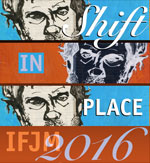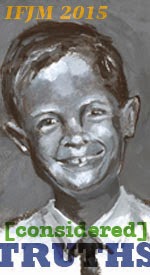If you are participating in the 2015 International Fake Journal Month (IFJM) celebration then chances are you have just completed your seventh entry in your journal (most participants do an entry a day).
Things might be barreling along at breakneck speed and the freedom you experience being another character is already spilling over into your other work.
For others the end of the week might seem bittersweet—plans for the month seem now further away than April first, your medium of choice is not working in unison with the paper and journal you selected, your character may be in a snit at your failure to grasp his or her true motives for sketching nothing but cigarette butts found on main street, and that sniffle you thought was allergies two days ago is now a full-blown head cold.
What to do?
Don't give up. Don't pack it in.
Realize this:
Starting a creative project of any time is never easy, especially when you are setting it up to dig deep within yourself and mine some essential truths about how you approach art and life.
The first time you participate in IFJM might seem particularly mined with explosive obstacles. You look around and see others (who have participated before or maybe never participated) churning out pages as if there was no tomorrow (or as if they had no other obligations in the world). Your small sketch on the page suddenly begins to seem smaller and more insignificant.
NONSENSE.
Your fake journal is going to be different from everyone else's because you and your goals are different.
Your journal, with its simple parameters that fit in your day also fits your goals, that's why you decided on it. Keep going, keep applying yourself to the goals you set and see what you discover.
If your project now seems overwhelming because you are having to do extra research into what's involved in medicinal botany when you've never grown a plant in your life (I hope I've picked a career no one is using this year—it's sometimes hard to keep track as characters don't announce it) and that extra research time leaves you with little sketching and writing time—don't beat yourself up.
If the medium you selected is making mud on all your pages—don't give in.
It's time to reassess, and tweak your project so that you can continue on through the month.
After you have completed the seventh day of your project it's the perfect time to reassess. Follow these simple steps, even if you think all is going well.
1. Ask yourself how you are connecting with your character.
2. How much time are you spending on your project each day—if it's more than 30 minutes a day are you on vacation and so have time to spare? If not take a serious look at the time you're spending on the project.
3. Are you happy with the sketches and writing that you are producing? If so, great, don't think more about it for now. (You can look at them again in as week 3 starts.) If you are not happy with your output take a look at what the causes of the dissatisfaction are. Is it because you are judging your writing and art? Do you have issues with your internal critic? If you never have before and now you're harshly judging your output here's a clue, you have issues with your internal critic that you've been in denial over. Take a moment not to address this fact and find a way to silence the critic for the duration of the project. I recommend that you come up with a statement as simple as "Shut UP" or as polite as "I'll speak with you about it in May, I'm sure you'll have lots to say." Use that statement EVERY TIME you find yourself getting into a judgmental frame of mind about your artwork. You might find yourself saying this every 30 seconds if the critic is really holding on tightly. He doesn't want you to go on because you are outside his comfort level. As an artist YOU get to set your own comfort level. Push your boundaries and tell your internal critic to take a hike.
If your "judgment" about your art and writing comes not from your internal critic but from your healthy art-process editor who makes helpful and specific comments for change like "this image's focus is lost here because there are no dark-darks next to the focal point" then use those comments to focus on those specifics in your next piece. BUT BE VERY CLEAR IN YOUR ASSESSMENT.
The one type of judgment tells you to shut down, the healthy type of assessment shows you clear paths for moving forward.
4. After you have assessed items 1 to 3 it's time to look at how you can switch things up to make the best of the remaining time in the project.
You might realize that it's important to simplify locations your character is in—so your character either returns home or stays in one spot for the duration.
You might find that it's important to decrease your time involvement. If so sit down with your character and ask her what she can work on in only 30 minutes. You can do a bit of creative negotiation.
The goal is ALWAYS to do something that is manageable so that you can get to the end of the project.
But it is also about maintaining your creative flexibility.
As an artist it is important to learn when it is time to switch things up within a project and be able to clearly distinguish that from a complex urge to quit.
One of the most valuable things you might learn on this project is your unique artistic temperament triggers. Don't continue day after day to struggle. Instead sit down with yourself and your character, and work out ways to keep going.
Some Possible Shifts To Make To Ensure Completion
1. Immediately reduce your time involvement to 30 minutes a day. If this means you can't do your research, then find a way to work around that. (Your character has to return home where things are familiar to the both of you is the easiest workaround here—but you'll find other creative ways to proceed.) If you're selected media requires 50 minutes to make a successful painting and you can't spend that this year then scale back or switch media, have your character ponder on it in your journal, and get on with something that you can work with in that time frame. This is creative reaction in action.
1b. would of course be change the medium you're working in. Let's face it, if you intended to work in watercolor and by day 2 realized that watercolors don't work in the book you selected think creatively about how your character can still work if he changes media or changes scope, or even simply starts working on loose sheets of watercolor paper, all the same size (or not) which will be placed in a box at then end of the project. DON'T SUFFER.
2. Let go of your expectations. Perhaps you thought each page would be a work of art? Well in any journal worth anything coming out of a creative mind there is experimentation and MESS. YEAH for MESS. Embrace the fact that your character is comfortable making a mess and still creating.
3. Adjust your expectations to what is possible given your life constraints around you. If you are sick realize that will have an impact. Keep working, but perhaps you only work for 15 minutes a day. If it's the middle of tax season and your real job is "accountant" what the heck are you trying to do? Really? You can keep your fake journal in March or May next year, and right now you can do something that takes only 4 minutes a day because that is all you have and I still want to encourage you to finish the project.
4. Ask your family to cut you some slack. If there are lots of demands on your time and you feel everyone else's needs are coming first, sit everyone down in the family and say, "Hey, I need this 30 minutes each day and unless you have a bleeding wound or limb loss don't knock on the door" (Or tell them to stay out of whatever room you use to create in.) One of the great gifts you can give yourself when working through IFJM is an improvement in family dialog over creative time (yours) and their expectations to have dibs on your time.
5. Join the
Facebook IFJM Group and start posting your journal pages there. You don't have to post all of them, just one or two. Then ask people questions. "My character shift is difficult because of X, how are you dealing with that?" The group is pretty engaged in sharing their work and their thoughts. And they are up to speed on what a fake journal is and why you are trying to keep one (OK they don't know your exact reason for trying to keep one unless you tell them, and you don't have to tell them that and they can STILL give you encouragement). There are several folks in the group who have participated in past years and know the pitfalls and issues that can arise. They can assure you that what's happening is first week jitters.
End of Week One Final Thoughts
Working on a month long creative project like IFJM is a way to build and strengthen creative muscles. You'll learn something about the media and approach you decide to take. If you have set your parameters well you'll learn something about the creative process and your process that will help you go forward in your journaling.
But strengthening creative muscles is a process similar to strengthening any muscle in your body. You would not decide to run a marathon in May and go out today and run 26 miles. If you have never run before you would run around the block once a day for a couple days, gradually work up to a mile, and from there alternate between 3 and 5 miles and so on, until you were able to improve both your speed work and your endurance and combine them in the final 26.6 (or whatever it is) run.
IFJM is exactly the same. If you've never done a creative project like this before you have to pace yourself. And if you are pacing yourself you'll see things you don't like about the first week's effort—BUT YOU MADE IT! And you're going to keep making it and keep improving if you keep having these self-assessment type discussions with yourself.
Remember this, don't kill the will to be creative by overburdening it. You can over burden that will by setting too expansive a project, too labor intensive a project, too research heavy a project, and even a project that is too dismal (sad, morbid, frightening, happy, joyous—whatever the opposite of your general disposition is).
Take a moment today to assess where you are in the project, how it is going, what is working, what isn't working and how you can change that aspect.
You are one quarter of the way there. At the end of this week you'll be halfway there. Keep going. Allow yourself to see this creative project through so that you can learn from it and use it as a springboard for other projects.






















